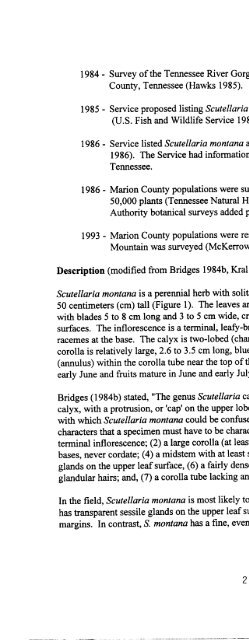Large-flowered Skullcap Recovery Plan - U.S. Fish and Wildlife ...
Large-flowered Skullcap Recovery Plan - U.S. Fish and Wildlife ...
Large-flowered Skullcap Recovery Plan - U.S. Fish and Wildlife ...
Create successful ePaper yourself
Turn your PDF publications into a flip-book with our unique Google optimized e-Paper software.
1984 - Survey ofthe Tennessee River Gorge located an additional population in Marion<br />
County, Tennessee (Hawks 1985).<br />
1985 - Service proposed listing Scutellaria montana as an endangered species<br />
(U.S. <strong>Fish</strong> <strong>and</strong> <strong>Wildlife</strong> Service 1985) <strong>and</strong> requested comments on the proposal.<br />
1986 - Service listed Scutellaria montana as endangered (U.S. <strong>Fish</strong> <strong>and</strong> <strong>Wildlife</strong> Service<br />
1986). The Service had information on 10 locations from Georgia <strong>and</strong><br />
Tennessee.<br />
1986 - Marion County populations were surveyed <strong>and</strong> determined to contain over<br />
50,000 plants (Tennessee Natural Heritage Program, no date); Tennessee Valley<br />
Authority botanical surveys added populations north ofthe previous range.<br />
1993 - Marion County populations were resurveyed (Faulkner 1993); Lookout<br />
Mountain was surveyed (McKerrow <strong>and</strong> Pyne 1993).<br />
Description (modified from Bridges 1984b, Kral 1983, Collins 1976, Epling 1942)<br />
Scutellaria montana is a perennial herb with solitary, erect, square stems, usually from 30 to<br />
50 centimeters (cm) tall (Figure 1). The leaves are lanceolate to ovate, on 1 to 2 cm petioles,<br />
with blades 5 to 8 cm long <strong>and</strong> 3 to 5 cm wide, crenate to serrate margins, <strong>and</strong> hairy on both<br />
surfaces. The inflorescence is a terminal, leafy-bracted raceme, with or without paired lateral<br />
racemes at the base. The calyx is two-lobed (characteristic ofthe genus Scutellaria). The<br />
corolla is relatively large, 2.6 to 3.5 cm long, blue <strong>and</strong> white, <strong>and</strong> lacking a fleshy ridge<br />
(annulus) within the corolla tube near the top ofthe calyx. Flowering occurs from mid-May to<br />
early June <strong>and</strong> fruits mature in June <strong>and</strong> early July.<br />
Bridges (1 984b) stated, “The genus Scutellaria can be easily recognized by its distinctive<br />
calyx, with a protrusion, or ‘cap’ on the upper lobe.” Within the genus there are other species<br />
with which Scutellaria montana could be confused. Bridges (1984b) listed some important<br />
characters that a specimen must have to be characterized as Scutellaria montana: (1) a<br />
terminal inflorescence; (2) a large corolla (at least 2.5 cm long); (3) tapering or truncate leaf<br />
bases, never cordate; (4) a midstem with at least some stipitate gl<strong>and</strong>ular hairs; (5) no sessile<br />
gl<strong>and</strong>s on the upper leaf surface, (6) a fairly densely pubescent lower leaf surface, often with<br />
gl<strong>and</strong>ular hairs; <strong>and</strong>, (7) a corolla tube lacking an annulus within.<br />
Inthe field, Scutellaria montana is most likely to be confused with S. pseudoserrata, which<br />
has transparent sessile gl<strong>and</strong>s on the upper leaf surface <strong>and</strong> hairs only on the veins <strong>and</strong> leaf<br />
margins. In contrast, £ montana has a fine, even-mixed gl<strong>and</strong>ular <strong>and</strong> nongl<strong>and</strong>ular “velvety”<br />
2

















